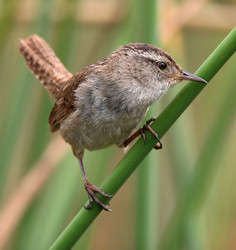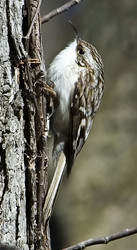Certhioidea
John Harshman


This tree diagram shows the relationships between several groups of organisms.
The root of the current tree connects the organisms featured in this tree to their containing group and the rest of the Tree of Life. The basal branching point in the tree represents the ancestor of the other groups in the tree. This ancestor diversified over time into several descendent subgroups, which are represented as internal nodes and terminal taxa to the right.

You can click on the root to travel down the Tree of Life all the way to the root of all Life, and you can click on the names of descendent subgroups to travel up the Tree of Life all the way to individual species.
For more information on ToL tree formatting, please see Interpreting the Tree or Classification. To learn more about phylogenetic trees, please visit our Phylogenetic Biology pages.
close boxDiscussion of Phylogenetic Relationships
This superfamily was erected by Cracraft et al. (2004) to cover a clade of four families removed from Sibley and Ahlquist’s (1990) Sylvioidea. It includes Troglodytidae (wrens), Polioptilidae (gnatcatchers), Certhiidae (treecreepers), and Sittidae (nuthatches) (Barker et al. 2002, 2004; Ericson and Johansson 2003; Beresford et al. 2005). Within this clade, Sittidae is basal and Troglodytidae and Polioptilidae are sister taxa (Sibley and Ahlquist 1990; Harshman 1994; Sheldon and Gill 1996; Ericson and Johansson 2003; Barker 2004; Alström et al. in press; but see Barker et al. 2002, 2004).
References
Alström, P., P. G. P. Ericson, U. Olsson, and P. Sundberg. 2006. Phylogeny and classification of the avian superfamily Sylvioidea. Mol. Phylogen. Evol. 38:381-397.
Barker, F. K. 2004. Monophyly and relationships of wrens (Aves: Troglodytidae): A congruence analysis of heterogeneous mitochondrial and nuclear DNA sequence data. Mol. Phylogen. Evol. 31:486-504.
Barker, F. K., A. Cibois, P. Schikler, J. Feinstein, and J. Cracraft. 2004. Phylogeny and diversification of the largest avian radiation. Proc. Natl. Acad. Sci. USA 101:11040-11045.
Barker, F. K., G. F. Barrowclough, and J. G. Groth. 2002. A phylogenetic hypothesis for passerine birds; Taxonomic and biogeographic implications of an analysis of nuclear DNA sequence data. Proc. R. Soc. Lond. B 269:295-308.
Beresford, P., F. K. Barker, P. G. Ryan, and T. M. Crowe. 2005. African endemics span the tree of songbirds (Passeri): Molecular systematics of several evolutionary "enigmas". Proc. R. Soc. Lond. B 272:849-858.
Cracraft, J., F. Keith Barker, M. J. Braun, J. Harshman, G. Dyke, J. Feinstein, S. Stanley, A. Cibois, P. Schikler, P. Beresford, J. García-Moreno, M. D. Sorenson, T. Yuri, and D. P. Mindell. 2004. Phylogenetic relationships among modern birds (Neornithes): Toward an avian tree of life. Pages 468-489 in Assembling the tree of life (J. Cracraft and M. J. Donoghue, eds.). Oxford University Press, New York.
Ericson, P. G. P., and U. S. Johansson. 2003. Phylogeny of Passerida (Aves: Passeriformes) based on nuclear and mitochondrial sequence data. Mol. Phylogen. Evol. 29:126-138.
Harshman, J. 1994. Reweaving the Tapestry: What can we learn from Sibley and Ahlquist (1990)? Auk 111:377-388.
Harshman, J. 2007. Classification and phylogeny of birds. Pages 1-35 in Reproductive biology and phylogeny of birds (B. G. M. Jamieson, ed.). Science Publishers, Inc., Enfield, NH.
Sheldon, F. H., and F. B. Gill. 1996. A reconsideration of songbird phylogeny, with emphasis on the evolution of titmice and their sylvioid relatives. Syst. Biol. 45:473-495.
Sibley, C. G., and J. A. Ahlquist. 1990. Phylogeny and classification of birds, Yale U. Press, New Haven.
Title Illustrations

| Scientific Name | Sitta carolinensis |
|---|---|
| Location | Knoxville, Tennessee, USA |
| Specimen Condition | Live Specimen |
| Source | white-breasted nuthatch |
| Source Collection | Flickr |
| Image Use |
 This media file is licensed under the Creative Commons Attribution-NonCommercial-ShareAlike License - Version 2.0. This media file is licensed under the Creative Commons Attribution-NonCommercial-ShareAlike License - Version 2.0.
|
| Copyright | © 2006 Wade Franklin |
| Scientific Name | Cistothorus palustris |
|---|---|
| Specimen Condition | Live Specimen |
| Source | Marsh Wren |
| Source Collection | Flickr |
| Image Use |
 This media file is licensed under the Creative Commons Attribution-NonCommercial-ShareAlike License - Version 2.0. This media file is licensed under the Creative Commons Attribution-NonCommercial-ShareAlike License - Version 2.0.
|
| Copyright | © Ashok Khosla |
| Scientific Name | Certhia americana |
|---|---|
| Location | John Heinz National Wildlife Refuge at Tinicum, Pennsylvania, USA |
| Specimen Condition | Live Specimen |
| Source | Hanging on the Vertical |
| Source Collection | Flickr |
| Image Use |
 This media file is licensed under the Creative Commons Attribution-NonCommercial-NoDerivs License - Version 2.0. This media file is licensed under the Creative Commons Attribution-NonCommercial-NoDerivs License - Version 2.0.
|
| Copyright | © 2006 Marty DeAngelo |
About This Page
Correspondence regarding this page should be directed to John Harshman at
jharshman@pacbell.net
Page copyright © 2006 John Harshman
 Page: Tree of Life
Certhioidea.
Authored by
John Harshman.
The TEXT of this page is licensed under the
Creative Commons Attribution-NonCommercial License - Version 3.0. Note that images and other media
featured on this page are each governed by their own license, and they may or may not be available
for reuse. Click on an image or a media link to access the media data window, which provides the
relevant licensing information. For the general terms and conditions of ToL material reuse and
redistribution, please see the Tree of Life Copyright
Policies.
Page: Tree of Life
Certhioidea.
Authored by
John Harshman.
The TEXT of this page is licensed under the
Creative Commons Attribution-NonCommercial License - Version 3.0. Note that images and other media
featured on this page are each governed by their own license, and they may or may not be available
for reuse. Click on an image or a media link to access the media data window, which provides the
relevant licensing information. For the general terms and conditions of ToL material reuse and
redistribution, please see the Tree of Life Copyright
Policies.
- First online 02 August 2006
- Content changed 02 August 2006
Citing this page:
Harshman, John. 2006. Certhioidea. Version 02 August 2006 (under construction). http://tolweb.org/Certhioidea/67306/2006.08.02 in The Tree of Life Web Project, http://tolweb.org/




.250a.jpg)


.100a.jpg)




 Go to quick links
Go to quick search
Go to navigation for this section of the ToL site
Go to detailed links for the ToL site
Go to quick links
Go to quick search
Go to navigation for this section of the ToL site
Go to detailed links for the ToL site